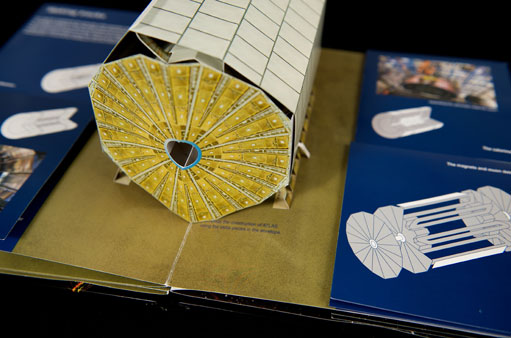
ATLAS e-News
23 February 2011
Pop-up book springs onto the scene
16 November 2009

The muon wheel and barrel of the (considerably easier to assemble) paper ATLAS, courtesy of Fons Rademakers
Just as the cathedral-sized underground jigsaw puzzle that is the ATLAS detector gets ready to start proving its worth, another complex construction project has recently reached its completion, just in time for Christmas: The ATLAS pop-up book.
Voyage to the Heart of Matter was officially launched to a press-packed room at the Royal Institution in London last week. Questions about the now infamous bird incident were surprisingly absent, with the book managing to cause enough of a stir to hold its own against the rogue winged intruder.
Over four deliciously detailed double-pages, the book tells the story of the LHC, the ATLAS experiment, and the mind-blowing truths they hope to discover together. With a total of 17 interactives – bits to pull, things to assemble, and structures to explore – one of the most exciting experiments of our lifetimes literally leaps from the pages.
The project was a joint effort between writer Emma Sanders and pop-up professional Anton Radevsky. “Anton has an amazing imagination and is extremely ingenious – every tab counts,” says Emma of her co-creator.
“A lot of people are excited about the start-up of the LHC but don't have a clue about how it actually works – it’s all very impressive, but might as well be a black box,” she says of the book’s unusual subject matter. “This is a fun and accessible way of finding out more.”
It may only be four double pages long, but the hefty book packs quite a punch, both in terms of its commanding three-dimensional physicality and its science content. “I didn't want to shy away from explaining how ATLAS actually works – the amazing technology that is needed to build these experiments and the sheer scale of it,” Emma says.
The journey begins by looking at the LHC – where it is, how it works, and the mechanics of colliding protons. The next page could be loosely described as dealing with ‘construction’ – of the detector, of the computing systems, and of the infrastructure that fuels and links the two.
On the third page, things start to get serious, with the anatomy of the ATLAS detector laid bare. Although the real-life detector took several thousand people over 15 years to design and build, you can assemble its diminutive cousin in mere minutes. In a more fairytale version of reality, the detector’s innards come ready made in an exciting little envelope with handy how-to instructions on the back.
What is arguably the most impressive page is saved until last. The Big Bang – exploding out of the page and forming matter, antimatter and eventually atoms, stars and galaxies – puts ATLAS’s research aims into context of the Universe and the questions that are yet to be answered about it.
The book has already caught the attention of the press and the blogosphere is buzzing. Head over to this week’s Photo Gallery to get a sneaky look at the book for yourself.
An express shipment of 500 copies is expected at the ATLAS Secretariat at the start of December, with a further 1000 due to arrive by December 8th. Don’t fret if you can’t make it to CERN before Christmas though – the book, which costs 30CHF from CERN or £20 from elsewhere will also be available to the world via the clicky magic of Amazon, and direct from the publisher, Papadakis.

Ceri PerkinsATLAS e-News
|